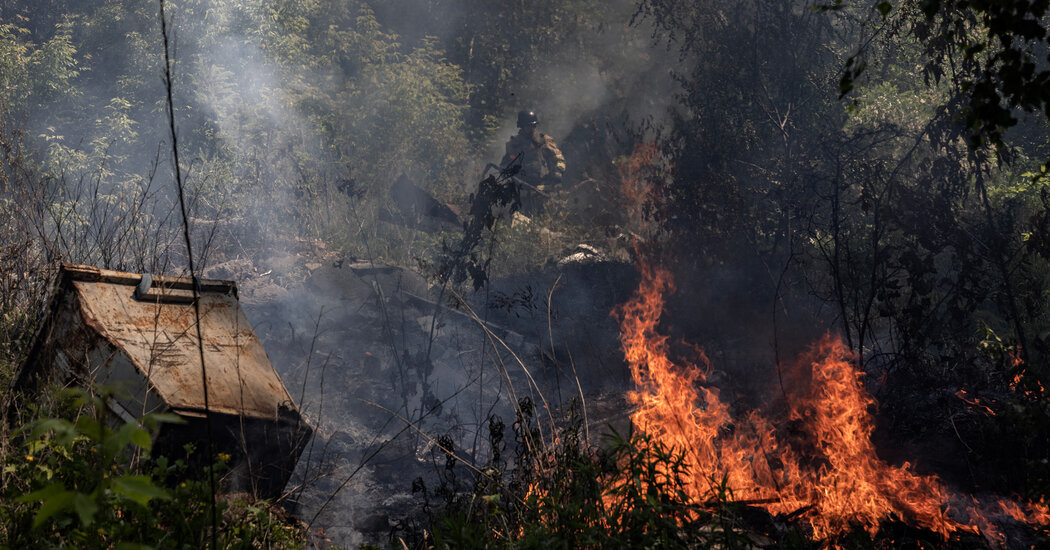
Senior Ukrainian military officials have warned that Russia is amassing troops near northeastern Ukraine, raising fears that a new offensive push could be imminent in a region that has become a pressure point on strained Ukrainian forces.
Gen. Oleksandr Syrsky, Ukraine's commander-in-chief, said Thursday that Moscow was redeploying troops toward Vovchansk and Lyptsi, two villages near the city of Kharkiv that Russian forces have been trying to capture for more than two weeks. Other officials also said Russia had massed troops further north, opposite Ukraine's Sumy region, in preparation for a possible ground offensive there.
“These forces are not enough to launch a full-scale offensive and break through our defenses,” General Syrsky wrote on Facebook on Thursday. However, he said, a reorganization of Ukrainian defenses in the area is underway to be ready to repel assaults.
Russia's incursion across the border into Kharkiv has introduced a distressing threat to the Ukrainian army, which is already under constant assault in the far southeast of Donbas. Commanders were forced to move troops north to shore up defenses while waiting for Western weapons to arrive in numbers large enough to make an impact.
The massing of Russian troops north of the border near the city of Sumy, about 90 miles northwest of Kharkiv, makes the situation even more precarious, expanding the amount of territory Ukraine must defend. Analysts say an offensive in the Kharkiv or Sumy regions could push Ukrainian troops to the breaking point and allow Russia to make inroads.
Earlier this month, Russian forces opened a front in the northeastern Kharkiv region, pushing their way through weak Ukrainian defenses in the area and quickly capturing a dozen settlements. Eventually Ukraine managed to halt the Russian advance by slowly falling back to more fortified positions.
But to repel Russian attacks, Ukrainian commanders have also had to mobilize reserves and redeploy elite units to the northeast, weakening their positions elsewhere along the front, such as in the eastern Donetsk region, where Moscow's forces are slowly advancing with bloody attacks. sieges of cities and villages.
Serhii Kuzan, president of the Ukrainian Center for Security and Cooperation, a non-governmental research group, said: “Russia's main goal is to expand the active front, disorganize the Ukrainian Defense Forces and deprive the Ukrainian command of the capability to use the reserves”.
Kuzan added that forcing Ukraine to divert troops northward would improve Russia's prospects of taking over the Donetsk region, which Moscow formally annexed in 2022 but does not fully control. Military analysts say gaining complete control of the region is a top priority for the Kremlin.
Rustem Umerov, Ukraine's defense minister, told Reuters on Tuesday that Russia was amassing thousands of troops preparing for a new push. “Their goal is to open a new front in the north to start using all their manpower and firepower against us,” she said.
Ukrainian officials have warned for several days that Russia has massed about 10,000 troops across the border from the Sumy region, a force they say is not strong enough to capture major cities but could immobilize Ukrainian units in the area.
Andriy Demchenko, a spokesman for Ukraine's border service, said this week that Russia was conducting reconnaissance missions there to reveal the location of Ukrainian defenses.
“Attempts by subversive groups have been recorded all along the border of the Sumy region,” Demchenko told Ukrainian media, adding that Russian troops at some point might “try to carry out actions similar to what we are seeing now in Kharkiv Region.”
Ukrainian officials have complained in recent months that they cannot prevent the buildup of troops just across the border on Russian territory because allies have banned them from firing Western weapons at Russia. Their calls to lift that ban have had some success in recent days in France; Poland; Sweden; and NATO Secretary General Jens Stoltenberg said Kiev should be allowed to strike military targets in Russia with those weapons.
The United States, the largest arms supplier to the Ukrainian government, has not agreed to lift the ban, even as debate has emerged within the Biden administration about easing the terms.
For now, Ukraine must try to repel Russian attacks along the entire front line. According to battlefield maps compiled by independent analysts based on satellite images and video footage of the fighting, Russian troops have recently made marginal gains in the Donetsk region. In particular, they reached the eastern outskirts of Khasiv Yar, a Ukrainian stronghold which is one of Moscow's main objectives.
Capturing Chasiv Yar would give Russian forces control of command heights in the area and expose cities that Ukraine uses as logistics centers to increased artillery fire.
General Syrsky said Thursday that Russia was supporting its ground attacks with airstrikes, using powerful guided bombs known as glide bombs that can carry up to a ton of explosives and can breach concrete bunkers. He said that Ukraine urgently needs anti-aircraft weapons to shoot down bomb-dropping planes.
Sweden said on Wednesday it would send more than $1 billion in military aid to Ukraine, its largest package yet, including air defense missiles along with surveillance and control planes capable of tracking fighter jets and bombers.
Ukraine's “ability to identify long-range targets will be strengthened,” Swedish Defense Minister Pal Jonson wrote on social media.
